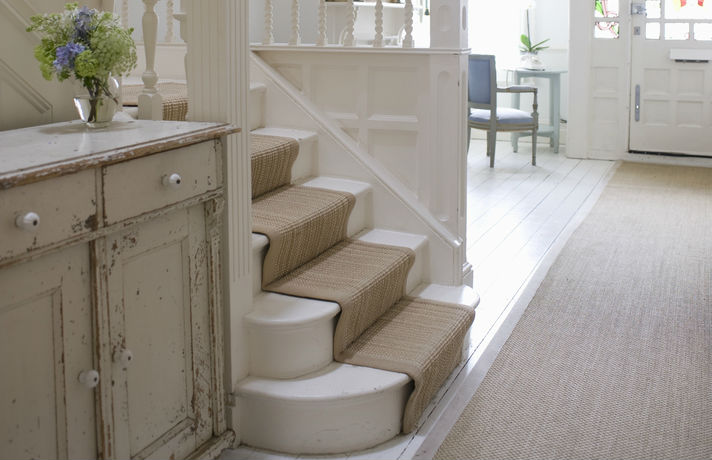There is nothing better than getting out of bed on a cold morning and stepping onto a warm, cozy carpet. While wood may be beautiful to look at, your toes will be happier snuggling into a luxurious carpet that keeps them off the sting of a frigid floor. Carpeting not only looks good, but it adds warmth to a room, provides a quieter environment and avoids an echo in a room with wood floors.

But putting down carpet can be daunting for the novice homeowner, but the process isn’t that difficult if you have the right tools. If you hire a pro, installation should include the initial measurement and suggest the best places to hide seams.
For homeowners that want the comfortable warmth of carpeting on their stairs, but love the beauty of wood, you can choose both. A carpet runner is a practical solution because it gives you the beauty of wood as well as the decorative and practical benefits of carpeting.
You don’t have to sacrifice the comfort for the beauty by implementing this clever compromise. The runner runs down the center of the staircase, leaving some wood exposed on each side of the tread. You get all the benefits of carpet, such as additional grip, shock absorption, and noise reduction.
Methods for Stairs
When carpeting stairs, there are two basic ways to attach the carpet. The traditional cap-and-band method involves running the carpeting down the riser, across the tread, and then tightly wrapping it around the nosing of each tread. To hold the carpeting in place, use an electric stapler to tack the carpeting to the underside of the nosing of the treads.
The second stair-carpeting method is called the waterfall treatment. This method allows the carpeting to flow from one step to the next without being tucked up under the nosing. The carpeting is tacked down along the rear edge of the tread, right where it meets the riser. The waterfall method imparts a more modern look and works best with carpeting that has smaller patterns.
Choosing Carpet
Once you’ve determined what type of style you want, it’s time to choose a carpet. When making your selection, keep in mind that a machine-hemmed, prefabricated stair runner is the most convenient choice for easy installation. If you opt to go for a carpet from a big roll, each side must be stitched with a border to prevent fraying and this hemming process requires a special sewing machine used by carpet professionals.
Measurements
Next, you have to take all of your necessary measurements to get the width and length necessary for your runner. Pre-hemmed runners are usually sold as 27 and 32 inches wide. Choose the size that fits your tread size with as much wood showing as desired. Calculate the length of your stair runner by measuring the depth of the stair tread and the height of the riser. Multiply this sum by the number of stairs.
Installing Tack Strips
Prepare your stairs by installing tack strips. These are thin pieces of wood resembling yardsticks with tacks pointing upward for gripping the carpet. Cut your tack strips into lengths four inches shorter than the width of your runner. Count out two strips for each stair. Nail one on each riser, centered, ¼ inch from the bottom, and one on each tread, ¼ inch from the rear, also centered.
Padding
For extra comfort when stepping down on the carpet, lay down a roll of carpet padding for cushioning. After cutting the padding into rectangles that are the same width as the length of each tack strip, secure it in place with hammer tacks. These pads should not cover any of the tack strips.
Carpet Installation
Working from the bottom of the stairs to the top, center the runner so that there are equal amounts of wood on each side, and then press it into the very first tack strip at the bottom of the riser. Use a carpet awl to get a clean look and then secure the runner to the riser just beneath the next tread with staples that are spaced roughly three inches apart.
Center the runner again and push the carpet back over the nosing and toward the next tack strip. Place the front part of a knee kicker about two to three inches from the second riser, then give it a jolt with your knee to tighten the carpeting along the edges. If the runner begins to buckle, pull it up from the tack strip and begin again.
Once you are satisfied with the runner’s position, use a carpet awl to push it tightly into the seam between the tread and the riser, and into your tack strips. Staple the runner into the crease where the riser and tread meet on either end of the strip as well as each outer edge, two inches from the bottom of the riser.
Repeat the Process
For each stair, until you reach the landing or top riser, repeat the process over again until the carpet installation is complete.
For those of you who have carpeting and are thinking of replacing it because they are stained and dirty, there’s another solution. A professional carpet cleaning process can potentially breathe new life into the carpet. Contact our team of experts at Kleenrite today and we’ll be ready to help you with all your carpet cleaning needs.

